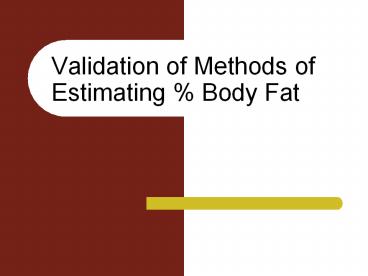Validation of Methods of Estimating % Body Fat - PowerPoint PPT Presentation
1 / 22
Title:
Validation of Methods of Estimating % Body Fat
Description:
Validation of Methods of Estimating % Body Fat How do you validate these techniques? There can be no direct validation Measure subjects with technique to get % fat ... – PowerPoint PPT presentation
Number of Views:128
Avg rating:3.0/5.0
Title: Validation of Methods of Estimating % Body Fat
1
Validation of Methods of Estimating Body Fat
2
How do you validate these techniques?
- There can be no direct validation
- Measure subjects with technique to get fat then
kill them, blend them and dissolve out lipid - Validation of Indirect techniques is by
comparison to other Indirect techniques - Which analysis indicates validity
- Correlation
- Test of Difference of means between tests
- Linear regression slope of unity
- Standard Error of Estimate
3
Regression Equationsto Predict Body Fat
Y mX c Y Body Fat X Anthropometric
measure (Skinfolds etc) Correlation Coefficient
(r) Standard Error of Estimate (SEE)
4
Predicting Fat from Density
ASSUMPTIONS Body can be divided into two
components Fat Non-Fat (Fat Free) Masses Each
has different, known and constant densities
5
SIRI EQUATION
Assumptions Density of FAT MASS 0.9
gm/ml Density of NON-FAT MASS 1.1
gm/ml Equation Fat (4.95/Density)-4.5) x 100
6
BROZEK EQUATION
Assumptions Density of FAT MASS 0.9
gm/ml Density of LEAN BODY MASS 1.095
gm/ml (some essential lipids in Lean Body
Mass) Equation Fat (4.57/Density)-4.142) x
100
7
Siri Equation Fat (4.95/Density)-4.5) x 100
8
Error in Prediction of Fat
Standard Error of Estimate for Fat from
Densitometry S.E.E. 2.77 Body Fat due to
variation in density of fat free mass Example
predicted value 15 Body Fat 95 confidence
in true value 15 1.96 x S.E.E. 15 (1.96
x 2.77) 9.57 - 20.43
9
Obvious Errors In 9 of 29 measured, the density
of FFM was clearly not 1.1 gm/ml
10
Variability of Constants
- The existence of this table infers that we should
know the precise density of FFM. - However, using arbitrary cut-offs between age
groups merely highlights the problem
11
DEXA vs. Hydro-Densitometry
12
Beware of the illusion of Validity
13
S.E.E - 1 SEE 1 SEE - 2 SEE 2 SEE
Density 1.04 gm/ml 0.005 gm/ml 1.035 1.045 1.030 1.050
Fat 26.0 Fat 2.29 Fat 28.3 23.7 30.6 21.4
68.26 Confidence 68.26 Confidence 95 Confidence 95 Confidence
14
BODPOD vs U W Weighing Influence of
clothingFields et al. 2000
- RESULTS In 67 females UWW Db (1.0300.020 g/cm3)
was higher (Plt0.01) than BOD POD Db (1.0280.020
g/cm3). This is a difference of 1.0 fat. - The R2 was 0.94, SEE was 0.005 g/cm3 and the
regression between Db by UWW and BOD POB did not
significantly deviate from the line of identity. - CONCLUSION This study supports the use of the
BOD POD as a substitute for UWW. However, caution
should be made in using the BOD POD if subjects
are clothed in anything other than a tight
fitting swimsuit.
15
Review of BODPOD vs U W WeighingFields et al.
2002
16
Review of BODPOD vs U W WeighingFields et al.
2002
- the SEEs reported in 4 of the 12 studies ranged
from 1.8 to 2.3 BF. These SEEs are in the
excellent to ideal range (2.5 BF) according to
Lohman (1992). - SEE 2.3 BF gives
- 95 confidence of 1.96 x 2.3 BF
- 95 confidence of 4.5BF
17
Review of BODPOD vs DEXAFields et al. 2002
- Note the SEE values (2.4 4.1 Body Fat)
18
BODPOD vs DEXAFields et al. 2002
- SEEs ranged from 2.4 to 3.5 BF?
- which were distributed among the good, very
good, and excellent categories, as subjectively
assessed by Lohman (1992) - SEE 4.1 BF gives
- 95 confidence of 1.96 x 4.1BF
- 95 confidence of 8BF !!!!!!
19
Which is better UW Weighing or Skinfold
predictions?
- Based upon densitometry
fat from skinfolds is predicted using equations
developed from UW Weighing of subjects. UW
Weighing S.E.E. 2.77 Fat Skinfolds
S.E.E. 3.7 Fat
20
Typical SEEs for Doubly Indirect Methods
21
The New York Obesity Research Center
- The assumed density of 1.1 g/cm3 is based on
observations made in a limited number of human
cadavers suggesting relatively stable proportions
of water, protein, glycogen and minerals. To the
extent that these proportions change in any
individual subject will introduce corresponding
errors in the assumed density of fat-free mass. - A number of studies suggest that the density of
fat-free mass is relatively stable across age and
sex groups, although some variation is recognized
at the extremes of age and in patients who have
underlying medical and surgical conditions. NOT
TRUE!!! - Additionally, there may exist race differences in
the density of fat-free mass as well as variation
among special groups such as body builders or
other types of athletic participants. Thus, while
underwater weighing and the two-compartment model
served as a reference technique for several
decades, newer approaches without these various
assumptions are now replacing hydrodensitometry
as the clinical reference method. MISLEADING!!!
22
Beware of Garbage
- BIA (Bioelectrical Impedance) - The only method
that is based on measuring something, not
estimating anything, is Bio-Impedance
measurement. Bio-Impedance is a means of
measuring electrical signals as they pass through
the fat, lean mass, and water in the body.
Through laboratory research we know the actual
impedance or conductivity of various tissues in
the body, and we know that by measuring current
between two electrodes and applying this
information to complex proven scientific formulas
accurate body composition can be determined. The
fact that the measurement is based on a reading
of lean mass and not an estimate of fat mass,
lends to a much more comprehensive testing method
and results.































